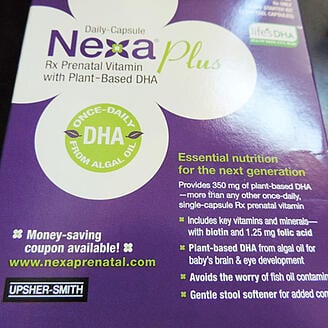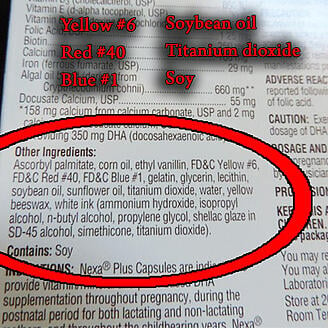Have you ever seen research questioning the value of vitamin and mineral supplements and wondered what the whole story was? Yes, ideally, we’d get all our holistic nutrition from food. But since most soils are deficient in nutrients, (especially minerals) due to industrial food production practices, getting all our nutrition from food is not realistic. So most of us pop vitamins and other dietary supplements to ensure we’re getting optimal levels of necessary micronutrients. Some of us pop more than others. And we’re getting handed them, just like this packet of samples my doctor recently gave me. [See photos below.]
But what if dangerous ingredients are lurking in your vitamin and mineral supplement? “No”, you exclaim. “Surely not! Those knights in shining armor at the FDA would spring into action to protect us…”
Sigh. Yet again, the political powers that should be protecting us are letting us down. And the industrial powers that be are tossing lots of lovely toxic fillers into your vitamin pills.
Here are the 5 worst (or most dangerous) things to look for in your dietary supplements. If you find them, don’t buy those supplements. Seriously. It's best to avoid a side of carcinogen with your micronutrients. Maybe it’s all the junk in vitamins and minerals that leads to the studies questioning whether they actually help us. B vitamins with a side of Red #40 probably aren’t going to lead to an optimal health outcome.
 Dangerous Ingredient #1: Artificial Colors
Dangerous Ingredient #1: Artificial Colors
Take a look at ingredient lists for any of the following synthetic (artificial) food colorings, all approved by the FDA:[1]
- FD&C Blue No. 1
- FD&C Blue No. 2
- FD&C Green No. 3
- FD&C Red No. 3
- FD&C Red No. 40
- FD&C Yellow No. 5
- FD&C Yellow No. 6
Why, oh why are there artificial colors in your vitamins?
The FDA states that these artificial colors in your vitamins are added to: “Offset color loss due to exposure to light, air, temperature extremes, moisture and storage conditions; correct natural variations in color; enhance colors that occur naturally; provide color to colorless and ‘fun’ foods.”
Do we really care if our vitamin pill has a lovely shade of red? Especially considering the FDA itself has “probed” into the connection between artificial food dyes and children’s behavior![2] Red #40 has been linked to hyperactivity and the Center for Science in the Public Interest, among others, wants the FDA to ban artificial food colors. After all, artificial colors in your vitamins serve no function other than making food look more “fun”, or even worse, cover up the fact that the active ingredients in the vitamin has been degraded by exposure to light, air, moisture, heat, or poor storage conditions.
Additionally, European lawmakers now require a warning label on foods that contain artificial dyes.[3] The label must state: “May have an adverse effect on activity and attention in children.”
 Dangerous Ingredient #2: Hydrogenated Oils
Dangerous Ingredient #2: Hydrogenated Oils
Here you thought you were avoiding hydrogenated fats by passing on the margarine. Did you know that your dietary supplement may also have these little toxic nasties? And, to make matters worse, its often partially hydrogenated soybean oil—one of the major fillers in the majority of vitamins today. Unless soy is organic, you can pretty much guarantee it’s genetically modified. So you’re getting a dose of franken-soy with your vitamins.
The FDA knows that hydrogenated fats are bad for us. The 2010 Dietary Guidelines for Americans[4] specifically states: “Keep trans fatty acid consumption as low as possible by limiting foods that contain synthetic sources of trans fats, such as partially hydrogenated oils, and by limiting other solid fats.”
The CDC chimed in, posting in January 2014 that:
Consuming trans fat increases low-density lipoprotein (LDL, or ‘bad’) cholesterol. This risk factor contributes to the leading cause of death in the U.S. – coronary heart disease (CHD). Trans fat may also have other adverse health effects like decreasing high-density lipoprotein (HDL, or ‘good’) cholesterol. Further reducing trans fat consumption by avoiding artificial trans fat could prevent 10,000-20,000 heart attacks and 3,000-7,000 coronary heart disease deaths each year in the U.S.[5]
So why does the FDA allow these dangerous ingredients in your supplements? They’re cheap fillers. People still have this idea that bigger is better. Until we realize that smaller can be just as good, manufacturers will use cheap nasty fillers to give us bigger horse sized pills.
It’s up to you to avoid them, folks.
Dangerous Ingredients #3: Lead, Mercury, & PCBs
Essential fatty acids (EFAs) are on everyone’s mind lately. They’ve been shown to be particularly important for pregnancy women, babies, and toddlers,[6] as well as for brain and heart health.[7] But not all brands are created equal. Since fish high on the food chain can accumulate mercury, lead, and other contaminants, those metals can make their way into your fish oil supplements. Yuck! Maybe these contaminants are the reason some research showed that fish oil supplements increased prostate cancer risk?[8]
The high levels of PCBs in fish oils led to a lawsuit in California in 2010 claiming that supplement manufacturers should have placed warning labels stating the cancer risk on their fish oil supplements.[9] Testing by Consumer Reports in 2011 showed 1/3 of the fish oils tested had high PCB levels.[10]
What? You don’t want a toxic heavy metal or some PCBs with your EFAs today? Then you’d better be careful of what brand of Omega-3 or EFAs you buy. This is not the time to choose the cheap option—make sure that you choose a variety that has been meticulously tested for lead or mercury contaminants. Your best choices should state that they are “Molecularly distilled and 3rd party tested to ensure PCBs, dioxins, mercury, lead and other contaminants are below acceptable limits set by the Council for Responsible Nutrition and other advisory agencies,” or something similar.
Here’s an even better option: choose wild fish, pasture raised eggs, or greens for a good dose of Omega-3s!
Dangerous Ingredient #4: Talc or Magnesium Silicate
Yes, it’s true. The same powder your grandmother used as deodorant can be found in many supplements as a cheap filler and anti-caking agent. Nasty!
Magnesium silicate is similar in composition to asbestos and can cause lung problems when inhaled (bad news for the workers who have to mine it). It is also often contaminated with asbestos in the mining process and is suspected to cause problems when ingested. For example, the Japanese prefer rice that has been treated with talc (it’s whiter) and this has been linked to the high rate of stomach cancer in Japan.[11]
Talc is not currently considered food grade by the FDA. Although they were considering setting upper limits for asbestos fibers and adding it to the GRAS list way back in 1979,[12] I couldn’t find whether any upper limits have yet been set. (Mind you, the FDA website is pretty impossible to navigate!) But talc is still found in supplements. Yuck!
Dangerous Ingredient #5: Titanium Dioxide
Titanium dioxide is yet another one of the nasty and dangerous ingredients in your vitamins or supplements; it is used as a colorant (it’s also used in many cosmetics). Titanium dioxide has a raft of health implications.
Titanium dioxide has been shown to cause lung inflammation[13] and damage,[14] so it’s yet another substance that has impact on workers at the production level. It has also been implicated in immune system function, with some studies showing DNA damage by Titanium dioxide nanoparticles, albeit marginal damage.[15] Just a wee bit of DNA damage with your vitamins.
Taken internally, it has been shown to cause kidney damage in mice[16] and to induce small intestine inflammation.[17] This is scary considering how many people suffering from Chrohn’s and gluten sensitivity are probably taking supplements containing Titanium dioxide.
Yet again, our health is risked so our vitamins can be a pretty color. Very disturbing. Avoid it.
The Solution
The big picture solution is to have an FDA that actually prevents toxic materials getting into our food supply (and dietary supplements are a part of that food supply). But since that seems unlikely any time soon, we have to take matters into our own hands:
- The best solution: Eat certified organic whole foods and take food-based supplements that are tested for heavy metal contamination.
- Read labels. If you spot any of these nasties in vitamins, take a photo of the label and Tweet it. Tag the manufacturer and store where you found it.
- Go post your photo on the manufacturer’s Facebook page asking why those toxic ingredients are there.
- Start a petition to get these ingredients out of our food supply.
- Write to the FDA asking that they follow the same cautions as Europe, such as their warning labels on foods containing artificial coloring.
- Research these ingredients at pubmed.com (the National Institute of Health) so you can answer anyone who comments (ignorantly) that these things must be safe if they’re in our food and not banned.
- Buy M&Ms in Europe ;)
If we all kick up a bit of a ruckus, manufacturers will take these dangerous ingredients out.
Now that you’re aware of all these nasty ingredients in your supplements, go check your cupboard and let us know if you find anything scary!
Editors Note: This blog post was originally published in May 2014 and has been updated for accuracy. (December 2016)
Disclosure of Material Connection: I am the CIO of American College of Healthcare Sciences, the Institution that publishes this blog. However, all opinions are my own. This blog may contain affiliate links. I am disclosing this in accordance with the Federal Trade Commission’s 16 CFR, Part 255: “Guides Concerning the Use of Endorsements and Testimonials in Advertising.”
This article is for informational purposes only. It is not intended to treat, diagnose, cure, or prevent disease. This article has not been reviewed by the FDA. Always consult with your primary care physician or naturopathic doctor before making any significant changes to your health and wellness routine.
References[1] Human Foods Program. (2024). Summary of Color Additives for Use in the United States. U.S. Food and Drug Administration. https://www.fda.gov/industry/color-additives/summary-color-additives-use-united-states-foods-drugs-cosmetics-and-medical-devices
[2] Fulton, A. (2011). FDA probes link between food dyes, kids’ behavior. NPR. Retrieved from http://www.npr.org/2011/03/30/134962888/fda-probes-link-between-food-dyes-kids-behavior
[3] Official Journal of the European Union. (2008). Regulation (EC) No 1333/2008 of the European Parliament and of the Council of 16 December 2008 on food additives. Retrieved from http://eur-lex.europa.eu/LexUriServ/LexUriServ.do?uri=OJ:L:2008:354:0016:0033:en:PDF
[4] U.S. Department of Agriculture and U.S. Department of Health and Human Services (2010). Dietary Guidelines for Americans. Retrieved from http://www.health.gov/dietaryguidelines/dga2010/dietaryguidelines2010.pdf
[5] Center for Disease Control and Prevention. (2010). Trans Fat. Retrieved from http://www.cdc.gov/nutrition/everyone/basics/fat/transfat.html
[6] MedlinePlus. (2014). Fish Oil. Retrieved from http://www.nlm.nih.gov/medlineplus/druginfo/natural/993.html
[7] American Heart Association. Getting Healthy (2014, May 14). Fish and Omega-3 Fatty Acid. [Web log post]. Retrieved from http://www.heart.org/HEARTORG/GettingHealthy/NutritionCenter/HealthyDietGoals/Fish-and-Omega-3-Fatty-Acids_UCM_303248_Article.jsp
[8] Salzberg, S. (2013, July 23). Those fish oil supplements might cause cancer. Forbes.com Retrieved from http://www.forbes.com/sites/stevensalzberg/2013/07/23/those-fish-oil-supplements-might-cause-cancer/ Referencing http://jnci.oxfordjournals.org/content/early/2013/07/09/jnci.djt174.abstract
[9] Finney, M. (2010, March 2). Lawsuit over contamination in fish oil supplements. ABC7news.com Retrieved from https://abc7news.com/archive/7306625/
[10] Warner, J. (2011, December 7). Consumer reports: some popular fish oil supplements may contain PCBs. WebMd.com Retrieved from http://www.webmd.com/diet/news/20111206/some-fish-oil-supplements-fishy-on-quality
[11] Merliss, R.R. (1971, September 17). Talc-treated rice and Japanese stomach cancer. Science 173 (4002), 1141-1142. [DOI:10.1126/science.173.4002.1141] Retrieved from http://www.sciencemag.org/content/173/4002/1141.long and http://ajcn.nutrition.org/content/31/11/2017.full.pdf
[12] U.S. Food and Drug Administration. (2013, April 18). Select committee on GRAS Substances (SCOGS) Opinion: Magnesium silicate. Retrieved from http://www.fda.gov/Food/IngredientsPackagingLabeling/GRAS/SCOGS/ucm260465.htm
[13] Gil-Soon CHOI, et. al. (2014, March 7). Titanium dioxide exposure induces acute eosinophilic lung inflammation in rabbits. Industrial Health. Retrieved from https://www.jstage.jst.go.jp/article/indhealth/advpub/0/advpub_2013-0105/_article
[14] Chang X., Fu Y., Zhang Y., Tang M., & Wang B. (2014, January). Effects of Th1 and Th2 cells balance in pulmonary injury induced by nano titanium dioxide. Environ Toxicol Pharmacol. ;37(1):275-83. doi: 10.1016/j.etap.2013.12.001. Retrieved from http://www.ncbi.nlm.nih.gov/pubmed/24378593
[15] Makumire, S., Chakravadhanula, V.S., Kollisch, G., Redel, E., & Shonhai, A. (2014, May 16). Immunomodulatory activity of zinc peroxide (ZnO2) and titanium dioxide (TiO2) nanoparticles and their effects on DNA and protein integrity. Toxicol Lett 227(1):56-64. doi: 10.1016/j.toxlet.2014.02.027. Retrieved from http://www.ncbi.nlm.nih.gov/pubmed/24631018
[16] Suxin Gui, Xuezi Sang, Lei Zheng, et. al. (2013). Intragastric exposure to titanium dioxide nanoparticles induced nephrotoxicity in mice, assessed by physiological and gene expression modifications. Particle and Fibre Toxicology. 10:4 doi:10.1186/1743-8977-10-4. Retrieved from http://www.particleandfibretoxicology.com/content/10/1/4
[17] Nogueira, C.M., Mendes de Azevedo, W., Dagli, M.L.Z., et. a. (2012 September 14). Titanium dioxide induced inflammation in the small intestine. World J Gastroenterol. 18(34): 4729–4735. doi: 10.3748/wjg.v18.i34.4729. Retrieved from http://www.ncbi.nlm.nih.gov/pmc/articles/PMC3442211/








